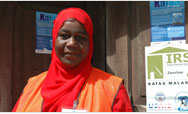International Day of Action for Women's Health - May 28, 2006
 |
| Source: Johns Hopkins University |
The International Day of Action for Women's Health was created to give a fresh look at women's unique health needs. A review of some of our programs:
Family Planning Saves Women's Lives
USAID's approach emphasizes voluntary programs in family planning, including the provision of a wide range of contraceptives, improved quality of care, and client-centered services. USAID's family planning programs are increasingly integrated with other community-based efforts to improve maternal and child health, enhance women's status, and prevent HIV transmission and other infectious diseases.
- Birth Spacing
Birth spacing of three to five years contributes to better health for women and their children.
- Contraceptives and Microbicides Research
USAID has been a leader in biomedical research for a range of high-quality contraceptives and in the development of microbicides to protect women against HIV/AIDS.
- Integrating Family Planning and HIV/AIDS Programs
Linking family planning and HIV/AIDS programs in the developing world provides women even greater access to comprehensive reproductive health care that can help them battle the disease and prevent transmission to their children.
Related Reproductive Health Programs Protect Women's Health
Listening to women; including them in planning, implementation, and decisionmaking; and validating the reality of their daily lives are all facets of successful programs to improve women's overall health. Women have both short-term practical needs (e.g., food, shelter, safety) and long-term strategic needs (e.g., economic viability, reproductive freedom, enhanced status). Some of USAID's programs address these issues and needs.
- Female Genital Cutting/Mutilation (FGC/M) Abandonment
Stopping the harmful practice of female genital cutting is crucial to women's health and their standing in society.
- Fistula Prevention
Because fistula occurs disproportionately in girls under 15 years old, USAID works to reduce adolescent pregnancies by promoting later marriages and expanding access to family planning services. USAID also supports fistula repair centers in 12 countries in Africa and Asia.
- Gender Issues
Reproductive health and HIV/AIDS outcomes can be improved by focusing on the prevention of gender-based violence, addressing the gender implications and vulnerabilities of HIV/AIDS, and increasing male involvement in family planning and reproductive health decisions.
- Postabortion Care (PAC)
PAC programs address women's needs through emergency treatment for complications of spontaneous or induced abortion; family planning counseling and service provision; and sexually transmitted infection (including HIV) evaluation, treatment, and counseling.
Maternal Health
 |
| Source: Johns Hopkins University |
In the last decade, USAID began innovative programming in low-cost, highly effective interventions in nutrition and maternal/infant health, building on previous investments and expertise. USAID uses a three-pronged approach to reduce maternal mortality that provides for integrated programs to serve women and children before and after pregnancy and through breastfeeding and early childhood. Improvements in maternal health impact other areas of development as well by increasing child survival, decreasing health care costs, and improving health productivity and household incomes. Program areas include:
- Maternal nutrition
- Birth preparedness and prenatal counseling
- Recognizing and managing complications of pregnancy and unsafe abortion and improving access to care
- Safe, clean delivery, postpartum, and newborn care, including counseling on family planning (especially birth spacing); proper rest, nutrition, and hygiene for the mother; awareness of possible signs of complications; and other reproductive health information
Additional Resources, Publications, and Tools
The DHS Gender Corner displays all of the Demographic and Health Surveys' gender-related activities, publications, data, and data collection tools. It has information by country on domestic violence, female genital cutting, and women's empowerment, among other gender topics. In addition, the Corner provides gender profiles of countries that have recently completed a DHS.
Women's Edition brings together senior women editors and producers from influential media organizations in different countries to examine and report on pressing issues affecting women's health and status in the developing world.
|


